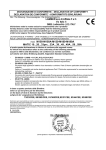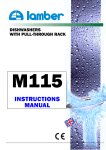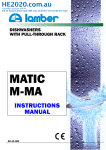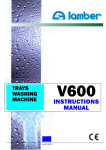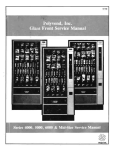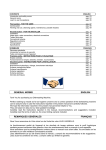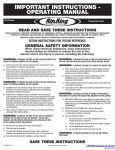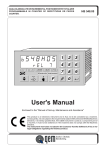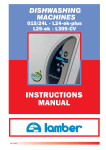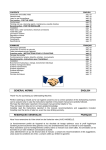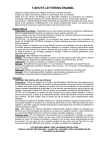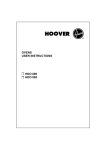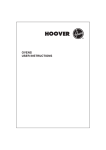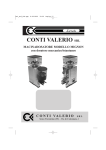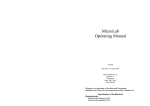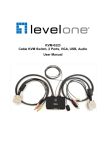Download mod. LINEAR 30 - 40 PRC - 60 PRC - 80 PRC
Transcript
DICHIARAZIONE DI CONFORMITA' - DECLARATION OF CONFORMITY DECLARATION DE CONFORMITE' - KONFORMITÄTS ERKLÄRUNG Noi - The following - Nous soussignés - Die Unterzeichnete Fa: dichiariamo sotto la nostra esclusiva responsabilità che il prodotto hereby declares under full responsability that the following product attestons sous notre entière responsabilité que le produit suivant erklärt unter eigener Verantwortung, dass folgende Produkte LAVASTOVIGLIE A NASTRO - LAVE-VAISSELLE A' CONVOYEUR – BELT TOWING DISHWASHERS – GESCHIRRWASCHMASCHINEN MIT FOERDERBAND mod. LINEAR 30 - 40 PRC - 60 PRC - 80 PRC al quale questa dichiarazione si riferisce è conforme alle seguenti norme: for which this declaration refers to the conformity of the following standards: auquel se référe cette dèclaration, est conforme aux normes suivantes: auf welche sich diese Erklärung bezieht, folgendem Standard entsprechen: - EN 60335-1 (1994) + A2,A5,A6,A51,A52,A53,A54,A55 Sicurezza degli apparecchi elettrici d'uso domestico e similare. Norme generali Safety of household and similar electrical appliances-General requirements. - EN 60335-2-58 (1997) Sicurezza degli apparecchi elettrici d'uso domestico e similare. Parte 2':Norme particolare lavastoviglie uso collettivo. Safety of household and similar electrical appliances-Part 2':Particular requirements for commercial electric dishwashing machines. - EN 292-2 (1992) Part 1' - PART 2' Sicurezza del macchinario-Concetti fondamentali-Principi generali progettazione-Specifiche e principi tecnici. Safety of machinery-Basic concepts-General principles for design-Tecnical principles an specification - EN 61770- (2000) Apparecchi elettrici connessi alla rete idrica. Disposizioni per evitare il ritorno d’acqua per effetto sifone e il guasto dei complessi di raccordo Electric appliances connected to the water mains. Avoidance of backsiphonage and failure of hose-sets in base a quanto previsto dalle Direttive: on the basis of what is foreseen by the Directives: selon ce qui est prevu par les Directives: aufgrund der vorgesehenen Richtilinien: 89/392/CEE, 91/368/CEE, 93/44CEE, 93/68CEE (MACHINERY) Decliniamo ogni responsabilità per sinistri a persone o a cose derivanti da manomissioni da parte di terzi o da carenze di manutenzione o riparazione. Nous déclinons toute responsabilité pour sinistres à personnes ou à objets qui derivent de l'intervention de la part de tiers non specialistes ou de carences de manutention ou reparation. We decline any responsability for injuries or damage derived from machine misuse, abuse by others or improper machine maintenance or repairs. Wir Iehnen jegliche Verantwortung für Schäden an Personen oder Dingen ab, die auf fehlerhaftes Eingreifen Dritter oder auf mängelhafte Wartung oder Reparation zurückzuführen. li 01/01/02 (data/date/Datum) (name signature or equivalent of authorized representative) TECHNICAL DATA AND DESCRIPTION The table reported at page 1 shows the basic models of belt-towing dishwashers and identifies the single washing areas to which additional modules can be added to improve their performance. ACCESSORIES DRYING TUNNEL STEAM CONDENSER HEAT RECOVER SYSTEM AUTOTIMER WATER PROTECTION WITH COLLAR BOOSTER PUMP TECHNICS SPECIFICATIONS Model: version Left-Right Right-Left ELECTRIC POWER kW ELECTRICAL INPUT A ELECTRIC CABLE mm2 CIRCUIT BREAKER A lcc ELECTRIC INPUT PRE-WASHING FIRST WASHING SECOND WASHING THIRD WASHING PRE-RINSING RINSING 6 kA TANK ELEMENT TANK ELEMENT TANK ELEMENT TANK ELEMENT TANK ELEMENT BOILER ELEMENT BOILER ELEMENT KW KW KW KW KW KW KW 2 KW KW Contents General norms page 05 Introduction and safety norms page 06 Unpacking and delivery checks page 08 1 – INSTRUCTIONS FOR THE USER page 09 First section - For the user – Operation before washing page 10 Control panel key page 12 Switch-on and use of the dishwashing machine mod. LINEAR page 14 Washing of dishes – Operations by washing page 15 Dishes positioning page 17 After washing operations page 18 Helpful suggestions - Achievements page 19 Safety devices page 20 Useful hints for stainless steel maintenance page 22 2 – INSTRUCTIONS FOR THE INSTALLER page 23 Installation page 24 Second section - For the installer – Detergents - Disposal page 25 Positioning – Electrical connection page 27 Water connections – Water draining page 28 Steam feeding – Steam exhaust – Vapours suction page 29 Testing – Work temperatures – Torque limiter page 30 Steam condenser page 31 Possible drawbacks – causes - remedies page 32 Wiring diagram page 37 3 4 INSTRUCTIONS MANUAL BELT-TOWING DISHWASHERS LINEAR The Belt-towing dishwashing machines of the LINEAR series are designed to wash any kinds of dishes . The modular system and the various optionals available allow the make-up of dishwashing machines with the most appropriate features in order to meet your production,space saving and energy-saving requirements. GENERAL NORMS ENGLISH Tank You for purchasing our Dishwashing Machine. Perfect washing-up results as far as hygiene concerns and a correct operation of the dishwashing machine can be assured only in case the instructions reported in the present manual are carefully followed. We hope the information reported in the present manual will be helpful to You. They are based on data and our best updated knowledge. Carefully read the Instructions reported in the manual, recommendations and suggestions included. Carefully read the terms of sale too, the ones limiting warranty included. 5 INTRODUCTION AND SAFETY NORMS INTRODUCTION This equipment is destined only to the use it has been conceived for: tableware washing such as dishes, glasses, cups, cutlery, trays, etc. Using it to wash machine components or objects whose dimensions are superior to the machine working passage is improper and therefore dangerous. - Equipment in compliance with EEC89/336 directive concerning the suppression of radio interferences and electromagnetic incompatibility. - In conformity with the EEC directives and the fulfilment laws, our dishwashers are built according to the regulations in force in Italy and abroad. - The noise of the machine running empty, measured at the working positions (fig. 1) and at 1.6m from the floor, is the following: Leq A Level equivalent of sound pressure dB(A) position 1 position 2 position 3 70 68 70 The level of peak sound pressure Lpc is not declared as it is much inferior to 130dB(C): PRELIMINARY OBSERVATION Carefully read the instructions reported in the present user manual, as it gives important indications about safety of installation, operation and maintenance: carefully keep the present manual for further consultations; the illustrations and drawings showing the machine are intended for general reference only and are not necessarily accurate in every particular; - the dimensions and characteristics of the machine, given in this Manual, are not to be considered binding and may be changed without prior notice; - having removed the packing material, check that all the equipment is present. If there is any doubt, do not use it and contact qualified personnel. The packing elements (plastic bags, nails, etc.) should be kept away from children, because they are dangerous. This equipment is destined only to the use it has been conceived for: tableware washing such as dishes, glasses, cups, cutlery, trays, etc. Using it to wash machine components or objects whose dimensions are superior to the machine working passage is improper and therefore dangerous. 6 GENERAL SAFETY REGULATIONS THIS SAFETY CODE HAS BEEN COMPILED IN YOUR INTEREST. Strict adherence to these rules will reduce the risks of injury both to yourself and to others; Personnel working with this machine must adhere strictly to all statutory safety regulations as well as the specific rules listed below. Failure to do so may result in personal inyury and damage to the machine; DO NOT attempt to move, install, set-up or operate this machine until you have read and fully understood this Manual. If doubt persists, ask your supervisor; never leave tools, parts or other loose material on or in the machine; Before switching the equipment the equipment on, make sure that the model plate data conforms to that of the electrical and water distribution network; remember that even with the mains isolator in the “OFF” position, the incoming cables are still live; BEFORE starting machine o cycle, after any maintenance or repair work, make sure all protective are correctly installed; be vigilant at all times, remember that your safety and that of your fellow workers depend on you; when moving or lifting the machine, care must be taken to comply with all the relevant regulations governing such operations; installation should be carried out by qualified personnel according to the manufacturer's instructions. this equipment should be destined to the use which it has been conceived for. Any other application should be considered improper and consequently dangerous; the equipment should only be used by personnel trained for its use; SPECIAL SAFETY REGULATIONS - - adjustement and repairs must be carried out only by personnel qualified. Repair carried out by unskilled personnel may be dangerous; perfect washing-up results as far as hygiene concerns and a correct operation of the washing machine can be assured only in case the instructions reported in the present handbook are carefully followed; the machine must be only used by authorized personnel which must comply with sanitary measures; do not leave the machine in environment with temperatures inferior to 0°C; the machine protection degree is IP55 for Control board and IP33 for machine, therefore it should not be washed with direct high pressure jets of water; 7 UNPACKING AND DELIVERY CHECKS When the case with the machine has been received, unpack it as follows: - Remove the upper cover and the wooden case side walls, take care not to damage the machine, - Remove possible accessories boxes, - Remove the protecting cellophane, - Make sure that the machine has not been damaged during transport, - Make sure that all covers and panels have been correctly fixed and that no loosen part is present, - Visually inspect that all electrical components are integral. TRANSPORT AND INSTALLATION - To lift and transport the machine, insert the truck forks under the frame connected to the points “F”, indicated by the yellow adhesives applied on the machine front side (see draw below). figura “A”* - Before plugging the machine, make sure that the supply voltage of the domestic wiring system and the water supply from water connection corresponds to the ones reported on the rating plate - Installation should be carried out by qualified personnel according to the manufacturer's indications During instalation, it is recommended to level the machine in order to ensure a correct operation. 8 INSTRUCTIONS FOR THE USER LINEAR First Section - FOR THE USER OPERATION BEFORE WORKING BEFORE STARTING - THE WORKING OPERATION BE SURE THAT: the wall-mounted on/off switch is switched on; the water and steam* cocks are open; water and steam (*) are present in the system; the filters and the overflow are in their housings; curtains are correctly positioned; the inspection doors are closed; the dimensions of the dishes to be washed do not exceed the washing working dimensions; Check that the detergent and rinse aid containers are not empty. (*) for steam machines only DETERGENTS In case the machine is not provided with an automatic dispenser, pour the detergent directly into the washing tank and uniformly distribute it on the filters in the doses indicated by the supplier. N.B.: If you use chlorinated sanitized detergents, it is always advisable to employ an automatic dispenser with feeler for the measurement of the detergent concentration, because brownish spots can appear on the surfaces due to chlorine reactions when pouring the detergent directly into the tank. In any case the product shall be introduced near the pump suction pipe into the tank and at least 15 cm far from the bottom in order to avoid corrosion. Choice of the suitable cleansing agent is an essential condition if you want to obtain extremely good washing results as concerns hygienic results. It is then important to consider some points. First of all only highly alkaline and chlorine-active antifoam products, especially made for industrial dish-washing machines, must be used and they must be produced by well known reliable Firms. We provide a short list just as an indication: Ecolab-Soilax; Henkel; Lever; Diversey; Relativ. Mean concentration of the powder cleansing agents must be 1,5-2,5 g/lt. Mean concentration of liquid cleansing agents must be 2-4 g/lt. In order to avoid scales and corrosions, put cleansing agent above water level on the nearest area of the sucking pump filter, in this way it will immediately dilute and will not deposit on the tank bottom. 10 DESCALING When hard water is used you can find, inside the machine and also on objects, calcareous sediments which must be removed both for hygienic and operating reasons by a descaling operation. Operating process and frequency of this intervention are suggested by your cleansing agent supplier who has suitable products, generally containing phosphoric acid. In order to avoid damage to the machine do not increase the quantities and once operations end rinse abundantly. HYGIENE At last each 30 days it would be useful to do this operation which guarantees the complete hygienic conditions of the machine. We suggest to contact your cleansing agent supplier who will give you quantity and name of the most suitable product you can use and that, generally, is an active chloride powder (100-200 ppm). In order to avoid damage to the machine do not increase the quantities and once operations end, rinse abundantly. 11 CONTROL PANEL LINEAR 0 AB D E F L S R C H I A1 H G P I M QC-LIN40 SYMBOLS USED FOR THE CONTROLS R MAIN ON/OFF SWITCH S SPEED SELECTOR START PUSHBUTTON I STOP PUSHBUTTON MACHINE OFF L PRE-RINSING ON TANK FILLING M OVERLOAD CUTOUT INDICATOR N PRE-WASHING ON C TIMED WASHING, FOR MACHINES WITH AUTOTIMER P DRYING ON D MACHINE-ON INDICATOR T FLOWMETER E 1ST SPEED RINSING THERMOMETER F 2ND SPEED PRE-WASH THERMOMETER G MACHINE READY INDICATOR WASH THERMOMETER A B CONTINUOUS WASHING TENTS POSITION QULIN-GBR H WATER INLET THERMOMETR SWITCH-ON AND USE OF THE DISHWASHING MACHINE (See page 12 and 13 for the symbols used) 1) Turn switch "A1" to position "I" and subsequently switch "R" to position Washing and belt-conveying are started up at this point and the machine is ready for the dish-washing (see page 15) "A". Line lamp "D" turns on and the tanks start being filled automatically . Lamp "G" turning on indicates that the appropriate level has been reached in the tanks and the heater elements have been switched on in the circuit . 5) Should it be required to stop the washing operations, push the button ”I” to stop the rack moving. Conversely, if the dishwashing machine has to be switched off completely, set switch "R" to position "O" . 2) Wait until the washing temperature is from 55° to 60° C and the rinsing one is from 80° to 85° C. Check the thermometers on the front panel . 6) The Pre-rinsing can be switched-off indipendentely through selectors "L" . In the case of machines provided drying, this can be switched-off indipendentely through selectors "P" . 3) On selector "S" select either position "E" or "F" for the first or respectively the second speed . 4) Then set switch "R" to position "B" . Then push the start button “H”. For subsequent operations, refer to the maintenance chapter . ! A sound signal will warn you when the conveyor belt is going to start. The safety sound signal will be on at any new start of the belt. N.B. Rinsing is operated automatically in correspondence with the dishes passing through . 14 WASHING OF DISHES DURING WASHING OPERATIONS 1) Fisrt of all, remove any food residues and any oily masses . 1) Check that the water temperatures are in accordance with the specified values : pre-washing 35÷45°C, washing 55÷60°C; rinsing 80÷85°C 2) Knives , forks and spoons should be previously softened; the same applies to dishes, should they be washed a long time after their use . 2) Monitor the levels of the detergent and the rinse agent liquid in the respective containers . 3) Arrange the dishes as shown in the figures (page 17) . 3) Remove the pre-wash filters (if any) (draw 4 – n.1 ) and the washing filter (draw 4 – n.2 ) periodically and remove any residues therefrom; it is suggested to buy another filter in order not to have to stop the machine for an extented period of time. 4) Push the rack toward the inlet of the machine. The feeding system will make it step up automatically . (N.B. Insert the shelves so that dishes are faced to the inlet and trays are parallel to the machine). 5) If the operator is not in a position to remove the dishes from the outlet bracket, they, upon reaching the end thereof, would cause the feeding system and rinsing to stop. In order to restore the operating conditions, it is sufficient to remove the object from the conveyor belt. Fig. 4 - pre-washing zone 4) Avoid dipping your naked hands into the soapy hot water present in the tanks. This can cause burns and skin irritations. In this case, immediately rinse them with plenty of water. 5) When the machine is working, do not open the inspection doors too quickly. 6) In case the conveyor belt is stopped by the safety device (limit switch), stop the 15 machine before removing the obstacle causing the trouble. Do not start it again until you are sure that the obstacle has been removed. 7) Desactivate the equipment in case of fault or malfunction. For repairs, only address to a technical assistance center authorised by the manufacturer and impose the use of original spare parts. The non-observance of the above could compromise the safety of the appliance and of the operators. For possible troubles occurring during the working cycles, see the relevant chapter. 16 DISHES POSITIONING POSITION THE KITCHENWARE ON THE CONVEYOR BELT ACCORDING TO THE WORKING DIRECTION OF THE MACHINE (see page 1 and 2 in the instruction manual). CUTLERY, CUPS AND GLASSES HAVE TO BE PLACED IN THEIR PLASTIC BASKETS; DISHES HAVE TO BE PLACED WITH THE CONVEX SIDE UPWARDS; THE TRAYS HAVE TO BE SECURED WITH THE ORANGE HOOKS IN THE MIDDLE OF THE BELT. G8 POS-STOVIGLIE-LINEAR CB 5- AFTER WASHING OPERATIONS PRECAUTION INSTRUCTIONS AND CLEANING - high temperatures can be reached inside the machine (90°C). Affter power supply has been removed, wait until the machine has reached the room temperature, before working on it; - never leave tools, parts or other loose material on or in the machine; - BEFORE starting machine or cycle, after any maintenance or repair work, make sure all protective are correctly installed; At the end of the working operations: fig.5 – Pre-rinse zone 1 – Push the STOP button “I” and rotate the switch "R" to position"0". Attention! For machines with Drying system it is necessary to wait 5 minutes before rotate the switch "R" to position"0"; This make Fan able to cool elements. 6- Wash the inside of the machine with a water jet. 7– When everything is clean and water is completely drained, take out and clean carefully the flat filters, the suction pump filters (draw 4 – n.2-4) and that of the pre-wash (if anydraw 4 – n.1) and wash them carefully every day (don't beat them against the floor or others) . 8– Remove and wash the splash-guard curtains. 9- For machines with steam condensation only, remove the steam aspiration filter (fig.5) end clean it. 2 - Take off the machine by means the disconnecting switch located on the control panel. 3 - IMPORTANT: Before carrying-out the cleaning and maintenance operations, disconnect the equipment from the mains voltage through the wall-mounted on/off switch and close the water and steam* supply cocks; 4- Lift the overflows (draw 4 – n.3) to empty the tanks. Make sure the overflow has also been removed (draw 5 no.6) from the pre-rinse tank after removing the upper drawer filter (draw 5 no.5) Lift the inspection doors making sure that they are firmly linked to the apposite support. . 18 Machine prolonged stop In case the machine is not used for some weeks it is advisable to carry out an accurate cleaning of all components inside to avoid the formation of unpleasant smells. fig.5 – Steam condenser 10 - 11 - 12 - In case of a very long standstill, it is advisable to oil the stainless steel surfaces with white mineral oil. Check that the washing nozzles are not clogged. If necessary, disassemble the nozzles and pay attention to assemble them again in the right position (twice a week) . HELPFUL SUGGESTIONS MAINTENANCE Remove the rinsing arms by rotating them counter-clockwise and check that the nozzles are not clogged: if otherwise, clean them using a needle (every week). IMPORTANT: Before carrying out cleaning and maintenance operations disconnect the machine from the power supply source by means of the wall-mounted switch or by means of the disconnecting switch located on the control panel. Replace the filters taking care that: Curtains shall have their shortest side turned towards the basket inlet (see the blue signalling marks located on the doors) WARNING! - Do not disconnect the switch when the machine is on! Check and frequently clean the nozzles. The frequency at which such operation shall be carried out will be suggested by the quantity of residues and scales and by the unsatisfying washing results. 13 - Clean the outside part of the machine using a wet sponge .Don't use water jets that, beside being dangerous, could also damage the electrical parts. Don't use detersive, abrasives, steel-wools or steel-brushes. 14 – To clean the machine outside and inside, never make use of corrosive products such as sodium hypochlorite (bleach) and hydrochloric acid (muriatic acid), acids in general, wire wool and steel brushes. In order to avoid the formation of nasty smells, let the doors open making sure that they are firmly linked to the apposite supports. To avoid compromising the correct operation and to keep the appliance in optimal hygienic conditions, it is advisable to carry out periodical sanifications and scale removing operations. * for steam machines only 19 ACHIEVEMENTS DOOR MICROSWITCHES Any deficiency in the washing process is apparent when dirty residuals are visible. Any halos might be caused by an insufficuent rinsing: in this case, check that the rinsing jets are clean and there is a sufficient pressure in the water distribution network (2÷4 bar) ; In the case that residuals are present, check that: • the washing jets are clean • pre-washing temperatur is 40 °C maximum; • washing temperature is from 55 to 60 °C, • rinsing temperature is from 80 to 85 °C, • there is detergent in the right concentration; • the filters are clean; • washing water is not dirty; • the positions of the objects on the conveyort belt are correct. Each inspection door is provided with two safety microswitches forming two redundant chains (safety level 2). If one of the doors accidentally opens, the pumps, the conveyor belt gearmotor and the rinsing area solenoid valve stop working. This way all washing operations are stopped preventing dangerous jets of hot water from spurting out. The operation is restored only when the doors are closed again and the start button “H” pressed. EMERGENCY STOP PUSHBUTTON Dish inlet and outlet side of the machine is equipped with a red mushroom-head pushbutton on yellow field, which, if pressed, stops all motors. Once the trouble has been removed, it is possible to restart the machine only after the pushbutton has been rotated and released. Subsequently press the start button “H” again. SAFETY DEVICES TORQUE LIMITER The belt conveyor dishwashers are equipped with a number of devices in order to ensure the safety of the operator and of the appliance itself. The belt forwarding feed system is equipped with a mechanical clutch coupling joint placed on the feed system. When an object incorrectly interposes between the machine and the belt, or the belt itself is overloaded, the forward feeding quickly moves to zero. In this case it is necessary to switch the machine off by means of stop or emergency pushbuttons, remove the obstacle and press the start pushbutton again. In order to adjust this safety device, see paragraph "MAINTENANCE”. LIMIT MICROSWITCH If dishes reach the end of the unloading area, before the operator has managed to unload the dishes, the limit switch stops the belt conveyor motion. 20 In this case, immediately rinse them with plenty of water. MOTOR PROTECTION DEVICES Each motor is protected against shortcircuits and current overload by automatic magneto-thermal relays. Lamp "M" switching on signalizes the intervention of any of these relays. In this case, the machine should be switched off and qualified personnel should be asked for repair. Risk of crushing the upper limbs As already said the conveyor plant is provided with a mechanical clutch torque limiter whose calibration depends upon the mechanical strength necessary to transport the tableware. Thanks to the presence of protection devices and to the segretation of dangerous moving parts, the risk of crushing the upper limbs has been removed. However never introduce your arms into the washing tunnel when the machine is running. ELEMENTS PROTECTION Each element is protected against short circuit by automatic breakers. Tank elements are protected against dry running by minimum level pressure switch. Boiler and dryer elements by thermostats with manual reset. In case of troubles, ask for the intervention of qualified and authorized personnel (see paragraph “Instructions for the installer”). FLOWMETER This device checks that the water flow is enough for a good final rinse. A red flash light “T” alarms if water pressure is too low. RESIDUAL RISKS Although the appliance is equipped with the above-mentioned safety devices, danger of burns to upper limbs persists. As already mentioned in the paragraph “DURING WASHING OPERATIONS”, avoid dipping your naked hands into soapy hot water of the tanks. This can cause burns and skin irritations. 21 USEFUL HINTS OF STAINLESS STEEL MAINTENANCE Stainless steel is so called because it is not affected by oxidation,this is due to a thin molecular layer of oxide on the surface which protects againts further oxidation. There are, howevwr, substances which can modify or destroy this layer,giving rise to corrosion:besides preventing the protective film of oxide from reforming,these substances corrode the stainless steel itself and can cause irreparable damage. It is therefore necessary to prevent this by choosing correct cleaning products and by complying with the following simple recommendations:never forget that when using these appliances,the first and fundamental rule is to guarantee that the cleaning products are both non-toxic and hygienic. Before using any detergent to clean either the stainless steel or the immediate and sorrounding floor area, always ask your supplier for the most suitable product which does not cause corrosion on the steel itself; the onset of rust is most commonly caused by the use of unsuitable cleaning materials (strongly acid chlorate based detergents) or on inadequate maintenance. Our appliances are made of stainless steel AISI 304 (18-10 type) for exterior panelling,upper tops,tanks etc. Comply with the following instructions when cleaning and servicing parts in stainless steel. Ordinary daily maintenance Carefully and frequently clean the surfaces using a damp cloth; use soap and water or normal detergents,so long as these do not contain abrasives or chlorine based substances such as sodium hypochlorite (bleech),hydrochloric acid or other such solutions:These products quickly and irreparably corrode stainless steel. When cleaning floors underneath or near the appliances, never use the above mentioned products as vapours or splashes could subject the steel to similar destructive effects. Only ever rub in the direction of the satining, then thoroughly rinse with clean water and carefully dry. Rust : water supply pipes, inevitably convey particles of rust dissolved in the water especially in new installation plants or when taps are opened after a period of inactivity. These iron deposits must not be allowed to remain on the stainless steel since they produce rust by contamination. Use suitable products to remove any rust marks,from companies which produce detergents for industrial use. After application, thoroughly rinse with clean water, neutralizing the action of the product with an alkaline detergent normally used to clean such appliances or with another specific product. DO NOT USE METAL MATS TO CLEAN THE STAINLESS STEEL INSTRUCTIONS FOR THE INSTALLER The following instructions are addressed to a qualified personnel, the only one authorised to carry-out checks and repair, if any. The Manufacturer declines any responsibility in the case of interventions made by a non qualified personnel. LINEAR Second Section - FOR THE INSTALLER The following instructions are addressed to qualified personnel who is the only one authorized to carry out the inspections and the necessary repairs. The machine should be installed into a “Normal” environment, that is to say indoors, free of dust, explosion-proof and adequately lit and well aired. Before installing the machine, it is necessary to arrange the electrical and water connections. See the reported wiring diagram (supplied by the manufacturer) of the selected model as far as the dimensions of pipes, cables and wall-mounted switch are concerned. In order to prevent damages caused by the escape of vapours from the equipment make sure that adjacent materials do not deteriorate in their presence. The Manufacturer cannot assume any responsibility for any damage to persons or property deriving from the non-observance of the above-specified norms. DETERGENTS The machine should also be equipped with a detergent and brightener dispenser, which shall be supplied by the manufacturer of these products. N.B.: If you use chlorinated sanitizers, it is always advisable to employ an automatic dispenser provided with feeler for the measurement of the detergent concentration, because brownish spots can appear on the surfaces due to chlorine reactions when pouring the detergent directly into the tank. The feeler for the measurement of concentration must be placed on the front side of the tank through the hole “A” preset for such operation (see drawing on page 27). In any case the LIQUID DETERGENT shall be introduced through the preset hole “B” on the right side of the washing tank. The choice of the right detergent is a necessary condition in order to obtain the best washing results as regards the hygienic al aspect. It is therefore necessary to consider some requirements. First of all, it is necessary to use only highly Alkaline Anti-foam Products and specifical Chloro-actives for industrial Dishwashers, made by companies of acknowledged reliability. Just as an indication we mention some of them: Ecolab-Soilax; Henkel; Lever; Diversey; Relativ. The average concentration of liquid detergents must be 2-4g/lter. In any case it is essential that the producer of the detergent rules the dosage properly according to the features of the installation. As regards the introduction of the liquid rinse aid product, use the passage “C” , placed near the water inlet group. This coupling will allow an appropriate introduction of the liquid rinse aid product. In order to do this use a fitting with nonreturn valve. To connect the dispensers there are four light blue terminals, marked with special labels, which are under tension when the pump is working. To avoid damages to the electrical components it is compulsory to use these terminals and avoid movable connections in other points of the plant. Terminal voltage corresponds to line voltage. DISPOSAL At the end of its life, the machine shall be disposed according to the local laws in force by specialized and acknowledged companies in this field. Its components shall be distinguished as follows: - metal components: body, plans, frames, filters; electric components: motors, remote control switch, microswitches, wiring; plastic components: baskets, connections; rubber components: hoses, sleeves. 26 all poles according to EN 60204 (VDE 113). POSITIONING During the installation provide a good leveling of the machine in order to allow it to work properly (doors, basket transport). The setting requires the ruling of the supporting feet. The mains must be wired to be able to handle the current drawn by the machine.The system must also be provided with a proper ground lead in accordance with the existings norms. The electric cable must be of the following type H07RN-F. For a correct selection of the cable rated cross-section refer to the data reported on the product data plate. The cable cross-section shall not be inferior to the one indicated in the “Technical data and description” reported in the first page of the present manual. The cable shall be connected to the isolator IA1 and to the adjacent yellowgreen terminal, it shall be made passed and stopped by means of the apposite cable grip. After removing the front panels, place the machine over the connections. Provide for the connections. The machine shall also be equipped with detergent and brightener dispensers, which shall be supplied by the manufacturer of these products. To connect the dispensers there are four light blue terminals, marked with special labels, which are under tension when the pump is working. To avoid damages to the electrical components it is compulsory to use these terminals and avoid movable connections in other points of the plant. Terminal voltage corresponds to line voltage. It is necessary to connect the equipment to an effective ground installation, as specified by the electrical safety regulations in force. Chack that this basic requirement is complied with and, in case of doubt, ask for a careful check of the installation by a qualified personal. In addition, the equipment shall be part of an equipotential system, the effectiveness of which should be checked according to the regulations in force. The connection should be made at the screw marked by the respective label ELECTRICAL CONNECTION Before connecting the machine, check to make sure the voltage outlet of the mains is the same as the voltage specified on the data plate of the machine. It is also necessary to check that the counter, the mains and the intake are adequately dimensioned to withstand the required maximum load. located on the equipment back side ( ). It is recommended to make the electric line be checked by your own designer. A main switch must be installed between the mains and the machine. This safety measure also requires that the minimum distance between the switch contacts is at least 3 mm and the disconnection on THE MACHINE SHALL BE CONNECTED WITH AN EFFECTIVE GROUND CLAMP. 27 excellent rinsing, it shall be calibrated according to the data reported on the plate located in connection with the reducer itself. The manufacturer declines any responsibility for any damages caused by lack of an effective ground installation. Emergency pushbuttons: Cold water supply The machine is also equipped with emergency pushbuttons located by the inlet and outlet tables of the machine. This connection is required only for machine with pre-wash and any other steam dishwasher equipped with condenser or regenerator. Water shall be supplied at a temperature ranging from 10-15°C and at a dynamic pressure of 2÷4 bar (200÷400 kPa). WATER CONNECTIONS Carefully comply with any national or regional regulations in force. Hot water supply WATER DRAINING Arrange a gate valve in an easily accessible place, with a tap having a 3/4"gas thread spout at its end and connect to the water inlet valve (fig.1) Reachable from the machine front side after opening the front panel (to do this turn the two front screws out); Arrange a discharge at floor level provided with siphon and connect to the floor drain by means of a hose provided with an adequate inclination. Make sure the drain hose is not choked in any way. Make sure the drain hose is resistant to a temperature of 70 °C. Carefully comply with any national or regional regulations in force. - temperatur : 55°C, Dynamic Pressure 2÷4 bar (200÷400 kPa), Hardness between 7,2 and 12,5 °F N.B.: Each machine is equipped with a pressure reducer. In order to obtain an 28 STEAM FEEDING * STEAM EXHAUST * As far as steam feeding is concerned, connect to the machine fittings indicated in the installation drawings. In order to make the equipment independent from the general steam distribution network, it is necessary to use gate and gas on/off valves (see draw 2 and 3).. The condensed steam exhaust shall have an appropriate slope toward the recovery installation or a blow-by pump, in order to guarantee an autonomous scavenging of the condensed steam. N.B.: for possible maintenance operations, it is advisable to arrange a gate valve parallel with the discharge so that it is possible to deviate condensation towards a runoff pit. * for steam machines only VAPOURS SUCTION For machines equipped with splashguard with collar or heat recovery, carry out the necessary connection as showed in figure 4. This type of feeding should be supplied at a pressure ranging from 1 bar (100°C) to 2 bar (121°C). In any case it is necessary to provide a way to extract steam through a hood or a similar system. The steam used should be absolutely saturated and dry. 29 TESTING PRE-RINSING The pre-rinsing thermostat (CT7) will be set according to the following temperature: Pre-rinsing water: 60°C. Before starting the machine: During the testing operations, prior to switching the dishwashing machine on, check that thermostat of the rinsing boiler (0°-90° C) is reset and the direction of rotation of the pumps is correct. DO NOT TAMPER WITH THERMOSTAT CALIBRATION THE TORQUE LIMITER Should the pumps rotate in the reverse direction, reverse two wires of the line . The limiter has already been described at paragraph “SAFETY DEVICES”. It is placed on the conveyor plant and it is calibrated while testing the machine. The magnetothermic switch of the boiler IA3 is open (OFF position). Let some empty racks pass through, then check that water jets sprinkle from the rinsing nozzles, then adjust the thermostat of the boiler to 85° C. In case it is necessary to calibrate the machine again, proceed as follows. 1. Switch the machine off. 2. Remove the protecting case. 3. Load the whole belt up to 50 cm far from the limit switch. 4. Loose the axial ring nut with the hexagon ring wrench type “A”; 5. Disengage the friction with a hooked key type “B” so that it slips; 6. At this point clockwise turn until the drawbar manages to carry the whole dishes charge; 7. It is considered adequately calibrated when, in second gear, by pressing the start pushbutton, the belt hardly manages to carry the whole load until the end of the delivery shelf. WORK TEMPERATURES Check that the thermostats are set according to the following work temperatures. If there is a PRE-WASH unit, check that the maximum thermostat (CT4), placed near the pre-wash tank, is ruled on the temperature of 45°C. ATTENTION! The cooling occurs thanks to the introduction of cold water with working wash pump. This device avoids the excessive growing of the pre-wash temperature. If there is also a thermostat for low temperature (CT9) for the heating element in the tank, rule it on the temperature of 3540°C. WASHING The tank thermostat (CT3), also placed near the wash tank, will be set according to the following temperature: Washing water: 55-60°C. RINSING The rinsing thermostat (CT2) will be set according to the following temperature: Rinsing water: 80-85°C. 30 Attention: before setting the clutch check the belt tension by ruling the screws of the turnbuckle in entrance.The right position must allow to lift the belt 10 centimeters over its support in the central part of it. This adjustment should be repeated 6 months after the first installation. STEAM CONDENSER As regards the machines provided with “STEAM CONDENSER” device, pay attention to the following: The adjustment of the device is carried out by means of the regulator valve (COCK “V”) placed inside the machine base plate and marked with its special label. The Manufacturer should rule this cock while testing the machine. Never touch this cock without a specific reason. This valve rules the water flow in the vapour condensing battery. If the machine needed a more precise adjustment, under regular conditions adjust the valve until no more vapour comes out of the “vapour condensing” cap. Generally it is sufficient to slightly open the valve. ATTENTION! An excessive opening can cause the cooling of the tank. 31






























